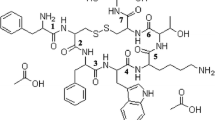Abstract
The purpose of this study was to develop a novel method to inhibit the formation of acylated peptide impurities in poly(d,l-lactide-co-glycolide) (PLGA) formulations by reversely blocking the amino groups of octreotide with maleic anhydride (MA). Two mono-MA conjugates with different modification sites (N terminus and Lys residue) and di-MA conjugate of octreotide were prepared and isolated by reversed-phase high-performance liquid chromatography (RP-HPLC). The polymer interaction of peptides and the formation of acylated peptides were monitored by RP-HPLC. The stability of MA-octreotide conjugates in PLGA films was studied in 0.1 M phosphate buffer (pH 7.4) at 37°C. The conjugation of MA to octreotide substantially inhibited the interaction of peptide with PLGA polymer and the subsequent formation of acylated peptide impurities. The MA-octreotides were successfully converted to intact octreotide as pH drops by PLGA hydrolysis. In PLGA films, MA-octreotide also showed complete inhibition of peptide acylation. In conclusion, MA conjugation provides a viable approach for stabilizing peptides in PLGA delivery systems.






Similar content being viewed by others
References
Anderson JM, Shive MS. Biodegradation and biocompatibility of PLA and PLGA microspheres. Adv Drug Deliv Rev. 1997;28:5–24.
Gombotz WR, Pettit DK. Biodegradable polymers for protein and peptide drug delivery. Bioconjug Chem. 1995;6:332–51.
Wischke C, Schwendeman SP. Principles of encapsulating hydrophobic drugs in PLA/PLGA microparticles. Int J Pharm. 2008;364:298–327.
van de Weert M, Hennink WE, Jiskoot W. Protein instability in poly(lactic-co-glycolic acid) microparticles. Pharm Res. 2000;17:1159–67.
Bilati U, Allemann E, Doelker E. Strategic approaches for overcoming peptide and protein instability within biodegradable nano- and microparticles. Eur J Pharm Biopharm. 2005;59:375–88.
Houchin ML, Topp EM. Chemical degradation of peptides and proteins in PLGA: a review of reactions and mechanisms. J Pharm Sci. 2008;97:2395–404.
Lucke A, Kiermaier J, Gopferich A. Peptide acylation by poly(alpha-hydroxy esters). Pharm Res. 2002;19:175–81.
Na DH, Youn YS, Lee SD, Son MW, Kim WB, DeLuca PP, et al. Monitoring of peptide acylation inside degrading PLGA microspheres by capillary electrophoresis and MALDI-TOF mass spectrometry. J Control Release. 2003;92:291–9.
Na DH, DeLuca PP. PEGylation of octreotide: I. Separation of positional isomers and stability against acylation by poly(d,l-lactide-co-glycolide). Pharm Res. 2005;22:736–42.
Murty SB, Thanoo BC, Wei Q, DeLuca PP. Impurity formation studies with peptide-loaded polymeric microspheres: part I. In vivo evaluation. Int J Pharm. 2005;297:50–61.
Murty SB, Na DH, Thanoo BC, DeLuca PP. Impurity formation studies with peptide-loaded polymeric microspheres: part II. In vitro evaluation. Int J Pharm. 2005;297:62–72.
Na DH, Lee JE, Jang SW, Lee KC. Formation of acylated growth hormone-releasing peptide-6 by poly(lactide-co-glycolide) and its biological activity. AAPS PharmSciTech. 2007;8(2):E105–9.
Chen F, O’Dorisio MS, Hermann G, Hayes J, Malarkey WB, O’Dorisio TM. Mechanisms of action of long-acting analogs of somatostatin. Regul Pept. 1993;44:285–95.
Lamberts SW, van der Lely AJ, de Herder WW, Hofland LJ. Octreotide. J N Engl J Med. 1996;334:246–54.
Murty SB, Goodman J, Thanoo BC, DeLuca PP. Identification of chemically modified peptide from poly(d,l-lactide-co-glycolide) microspheres under in vitro release conditions. AAPS PharmSciTech. 2003;4:E50.
Lucke A, Fustella E, Tessmar J, Gazzaniga A, Göpferich A. The effect of poly(ethylene glycol)-poly(d,l-lactic acid) diblock copolymers on peptide acylation. J Control Release. 2002;80:157–68.
Houchin ML, Neuenswander SA, Topp EM. Effect of excipients on PLGA film degradation and the stability of an incorporated peptide. J Control Release. 2007;117:413–20.
Sophocleous AM, Zhang Y, Schwendeman SP. A new class of inhibitors of peptide sorption and acylation in PLGA. J Control Release. 2009;137:179–84.
Zhang Y, Sophocleous AM, Schwendeman SP. Inhibition of peptide acylation in PLGA microspheres with water-soluble divalent cationic salts. Pharm Res. 2009;26:1986–94.
Na DH, Murty SB, Lee KC, Thanoo BC, DeLuca PP. Preparation and stability of poly(ethylene glycol) (PEG)ylated octreotide for application to microsphere delivery. AAPS PharmSciTech. 2003;4:E72.
Na DH, Lee KC, DeLuca PP. PEGylation of octreotide: II. Effect of N-terminal mono-PEGylation on biological activity and pharmacokinetics. Pharm Res. 2005;22:743–9.
Park EJ, Tak TH, Na DH, Lee KC. Effect of PEGylation on stability of peptide in poly(lactide-co-glycolide) microspheres. Arch Pharm Res. 2010;33:1111–6.
Hermanson GT. Bioconjugate techniques. 2nd ed. London: Academic; 2008.
Houchin ML, Heppert K, Topp EM. Deamidation, acylation and proteolysis of a model peptide in PLGA films. J Control Release. 2006;112:111–9.
Ryu KW, Na DH. Stability of octreotide acetate in aqueous solutions and PLGA films. J Kor Pharm Sci. 2009;39:353–7.
Wong SS. Chemistry of protein conjugation and crosslinking. Boston: CRC Press; 1991.
Na DH. Effect of pH on the formation of acylated octreotides by poly(lactide-co-glycolide). J Pharm Invest. 2010;40:251–4.
Kang JS, Deluca PP, Lee KC. Emerging PEGylated drugs. Expert Opin Emerg Drugs. 2009;14:363–80.
Maeda H, Bharate GY, Daruwalla J. Polymeric drugs for efficient tumor-targeted drug delivery based on EPR-effect. Eur J Pharm Biopharm. 2009;71:409–19.
Acknowledgments
This work was financially supported by the Ministry of Knowledge Economy (MKE) and Korea Institute for Advancement in Technology (KIAT) through the Workforce Development Program in Strategic Technology.
Author information
Authors and Affiliations
Corresponding author
Rights and permissions
About this article
Cite this article
Ahn, J.H., Park, E.J., Lee, H.S. et al. Reversible Blocking of Amino Groups of Octreotide for the Inhibition of Formation of Acylated Peptide Impurities in Poly(Lactide-co-Glycolide) Delivery Systems. AAPS PharmSciTech 12, 1220–1226 (2011). https://doi.org/10.1208/s12249-011-9694-y
Received:
Accepted:
Published:
Issue Date:
DOI: https://doi.org/10.1208/s12249-011-9694-y




